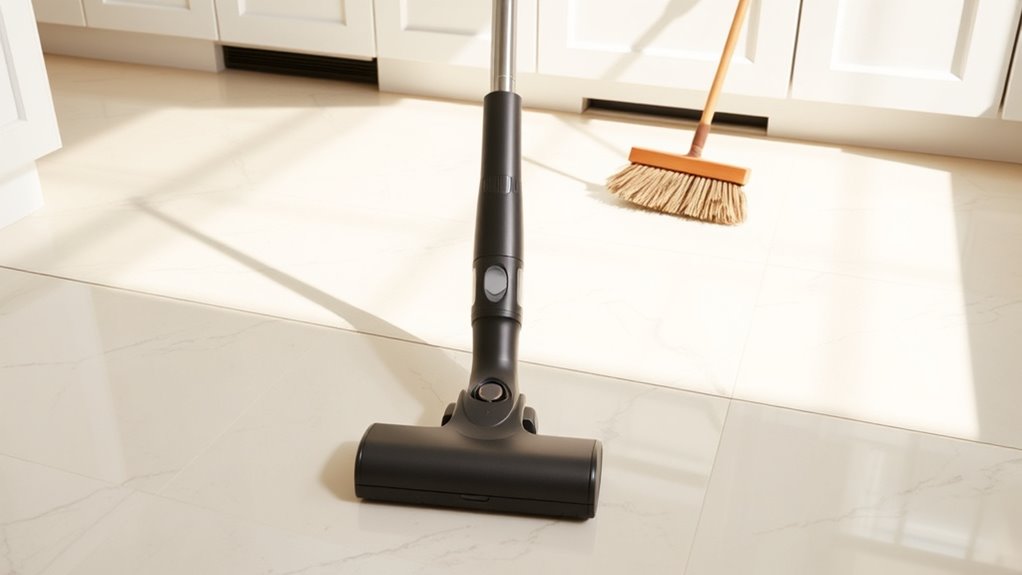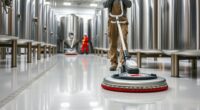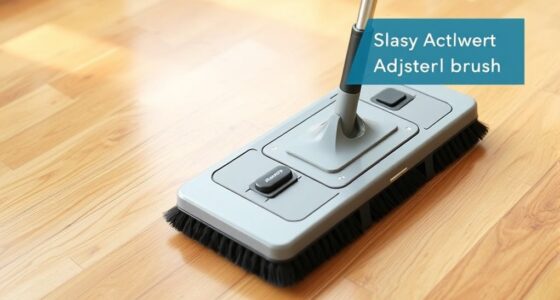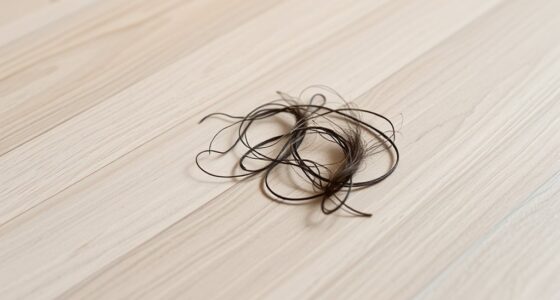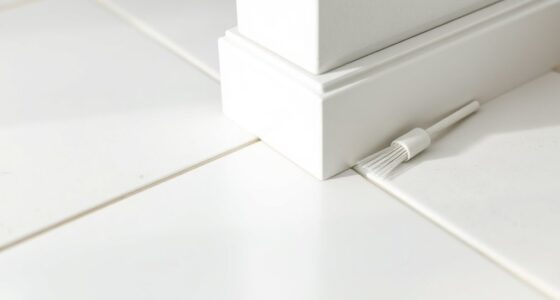When choosing between sweeping or vacuuming your tile floors, consider your cleaning needs and convenience. Robotic cleaners are perfect for automatic, daily maintenance, reaching under furniture and saving you time. Handheld sweepers are ideal for quick spot cleanups, especially spills or pet hair. Both tools complement each other for a thorough clean. To find out which option best suits your routines and space, explore more about their features and benefits.
Key Takeaways
- Use robotic cleaners for daily maintenance and effortless cleaning of tile floors.
- Opt for hand-held sweepers for quick spot cleans and hard-to-reach corners.
- Consider your space size and debris type to choose between automated and manual tools.
- Combine both tools for comprehensive cleaning and optimal floor hygiene.
- Select devices with advanced sensors and filters for efficient, allergen-reducing tile floor care.
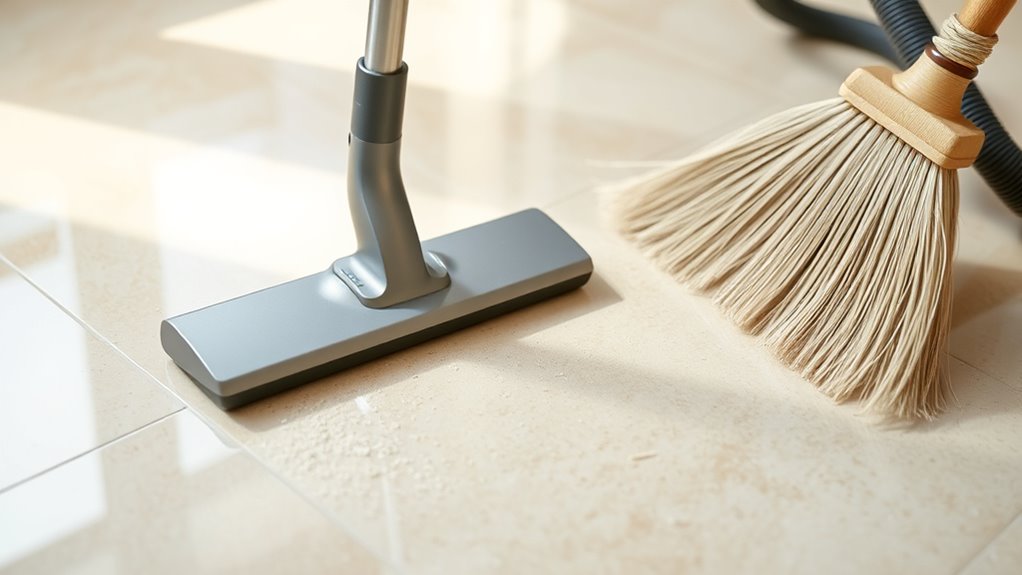
Keeping your tile floors clean is essential for maintaining a fresh and healthy home, but deciding whether to sweep or vacuum can be confusing. The right choice depends on your specific needs, the size of your space, and the type of debris you’re dealing with. When it comes to modern cleaning tools, robotic cleaners and hand-held sweepers are popular options that can make your task easier and more efficient. Understanding their strengths will help you choose the best tool for your tile floors.
Robotic cleaners are a convenient solution if you want to keep your floors consistently tidy with minimal effort. These autonomous devices can navigate your space, picking up dust, dirt, and debris without your direct involvement. They’re especially useful for daily maintenance, reaching under furniture and into tight corners where traditional tools might miss debris. Many robotic cleaners are equipped with sensors to avoid obstacles and can be scheduled to run at specific times, saving you time and energy. If you have a busy schedule or dislike manual cleaning, investing in a robotic cleaner can be a game-changer. Plus, they often come with HEPA filters, which trap allergens and improve indoor air quality, making them ideal for homes with allergy sufferers.
On the other hand, hand-held sweepers are lightweight, easy to maneuver, and perfect for quick cleanups. They’re especially handy for spot cleaning spills, crumbs, or pet hair that accumulates on tile floors. Hand-held sweepers don’t require electricity or batteries, so they’re convenient for on-the-spot use. They’re also a great choice if you want to clean small areas or corners, where larger vacuum cleaners might be cumbersome. Using a hand-held sweeper allows you to control the amount of debris you pick up, and many models come with flexible brush attachments to loosen stubborn dirt. They’re affordable, easy to store, and require minimal maintenance, making them a practical choice for everyday tidying.
Ultimately, choosing between robotic cleaners and hand-held sweepers depends on your lifestyle and cleaning needs. If you prefer a set-it-and-forget-it approach, a robotic cleaner can keep your tile floors looking pristine with little effort. If you want quick, targeted cleanups, a hand-held sweeper is your best bet. Both tools can complement each other, providing thorough cleaning options for your tile floors. By understanding their features and benefits, you can select the right tool that fits your routine, keeps your home hygienic, and saves you time. Additionally, considering the technology used in modern cleaners can help you make a more informed decision. Whether you lean toward automation or manual control, making the right choice ensures your tile floors stay spotless and inviting.
Frequently Asked Questions
Can I Use a Robot Vacuum on Tile Floors?
Yes, you can use a robot vacuum on tile floors. Many robot vacuums are designed with tile compatibility in mind, making them effective for cleaning. Just make certain you select a model with gentle brushes and adjustable suction, so you don’t damage your tiles. Regular use of a robot vacuum can keep your tile floors spotless without much effort, making it a convenient cleaning solution for your home.
How Often Should I Sweep or Vacuum Tile Floors?
You should sweep or vacuum your tile floors at least twice a week to maintain clean floors. The floor cleaning frequency depends on the dirt accumulation rate in your home; if you have pets or high foot traffic, consider doing it more often. Regular cleaning prevents dirt build-up and keeps your tile looking its best. Adjust your routine based on how quickly dirt and debris gather in your space.
Are There Specific Vacuums Better for Textured Tile?
Textured tile can trap more dirt, so you need a vacuum with strong power and versatile brush attachments. Look for models that offer adjustable suction to avoid damaging delicate surfaces. A vacuum with rotating brushes effectively loosens debris from grooves, making cleaning easier. Avoid weak suction vacuums—they just push dirt around. Instead, choose one designed to handle textured surfaces for a thorough, efficient clean every time.
Is It Safe to Use a Wet Mop After Sweeping or Vacuuming?
Yes, it’s safe to use a wet mop after sweeping or vacuuming your tile floors. First, make certain you’ve removed loose debris with a vacuum or broom. Use a proper cleaning solution suited for tile, then mop with a damp, not soaked, mop. Pay attention to drying techniques by quickly drying the floor with a clean cloth or towel to prevent water spots or damage. This keeps your tile looking clean and fresh.
What Are the Best Tools for Removing Stubborn Grout Stains?
For stubborn grout stains, you should use a grout cleaning brush or a toothbrush with stiff bristles, combined with a grout stain removal solution or a mixture of baking soda and water. Apply the solution, scrub gently but firmly, and let it sit before rinsing. For tougher stains, a commercial grout cleaner can be effective. Always test in a small area first to avoid damaging your tile or grout.
Conclusion
So, whether you opt to sweep or vacuum your tile floors, remember that choosing the right tool makes all the difference. Think of it as hitting two birds with one stone—keeping your floors spotless without wasting time or effort. By understanding your specific needs, you guarantee your floors stay sparkling and inviting. After all, a clean home is a happy home, and with the right approach, you’ll have it looking its best in no time.
